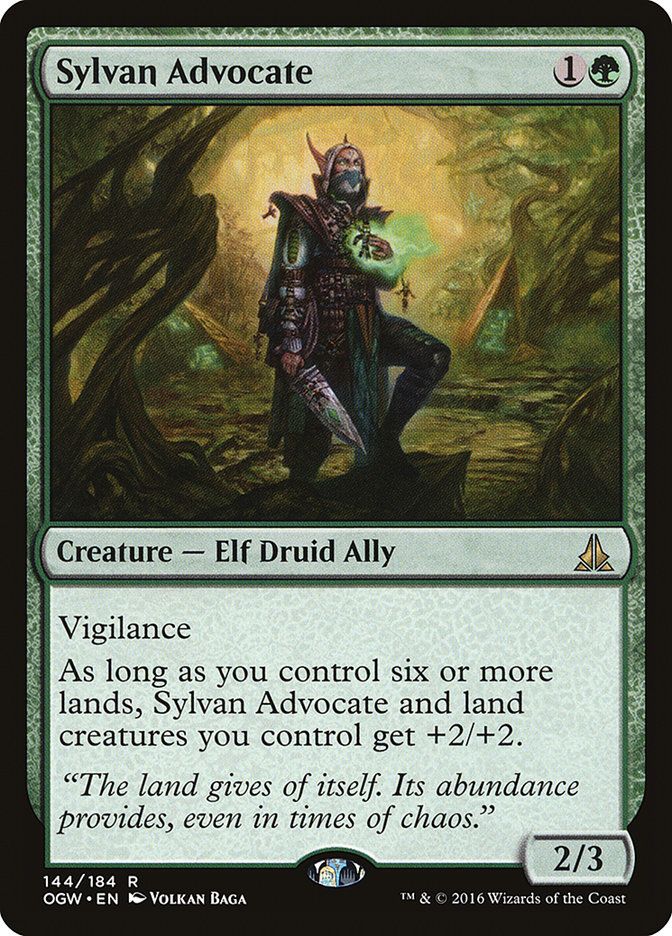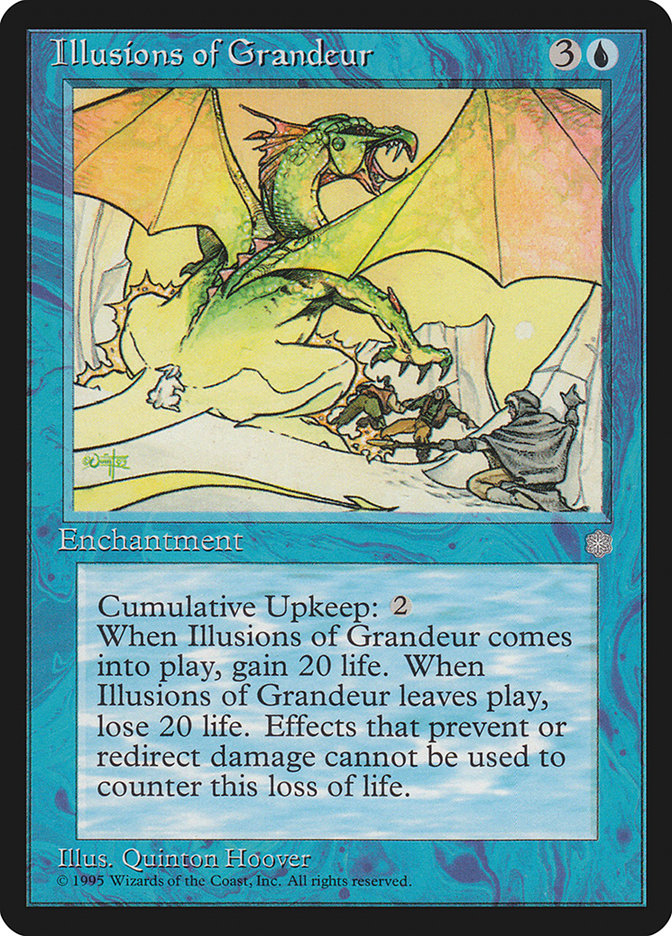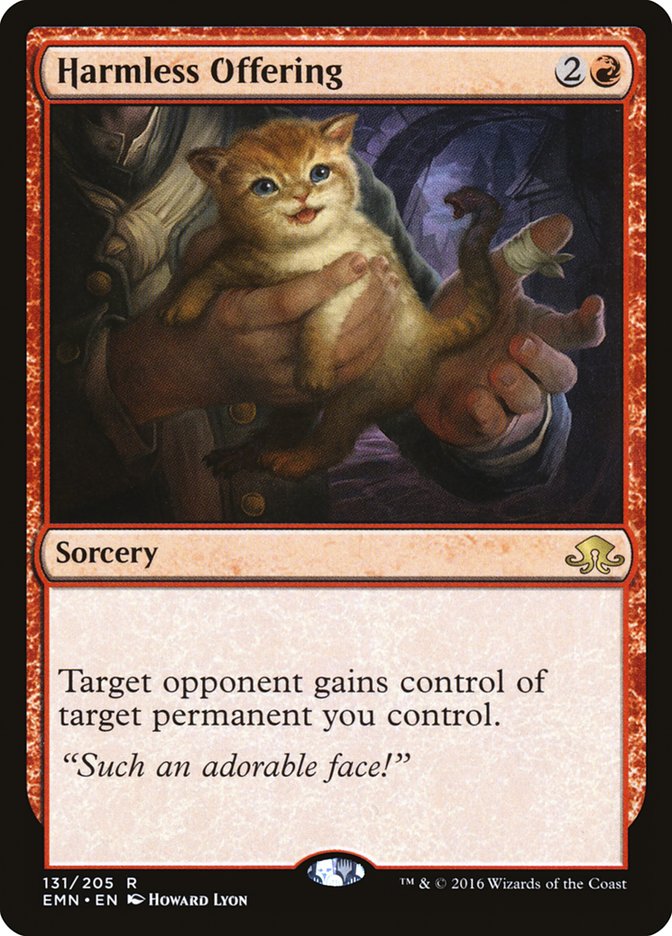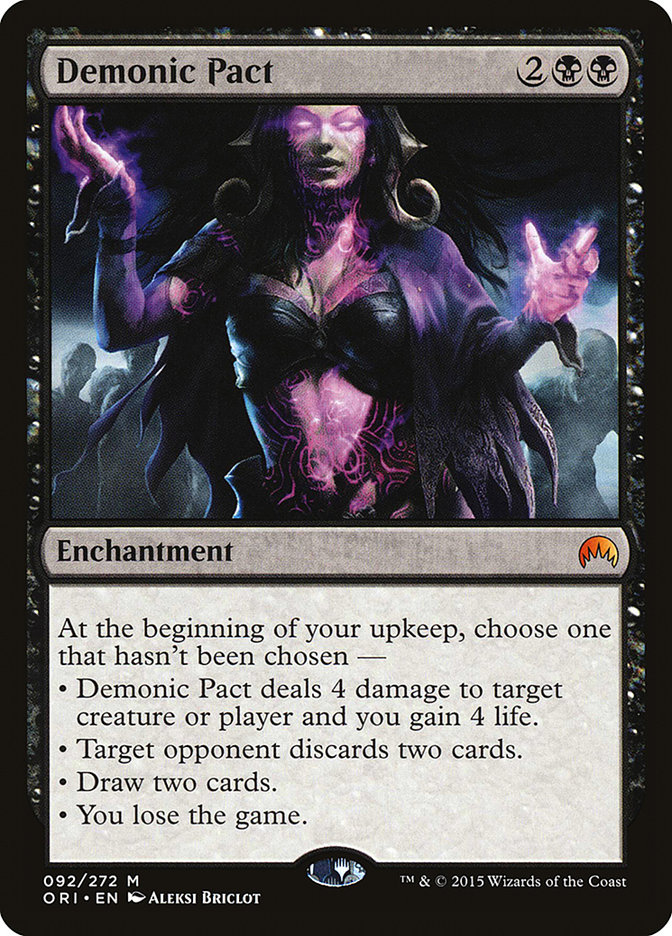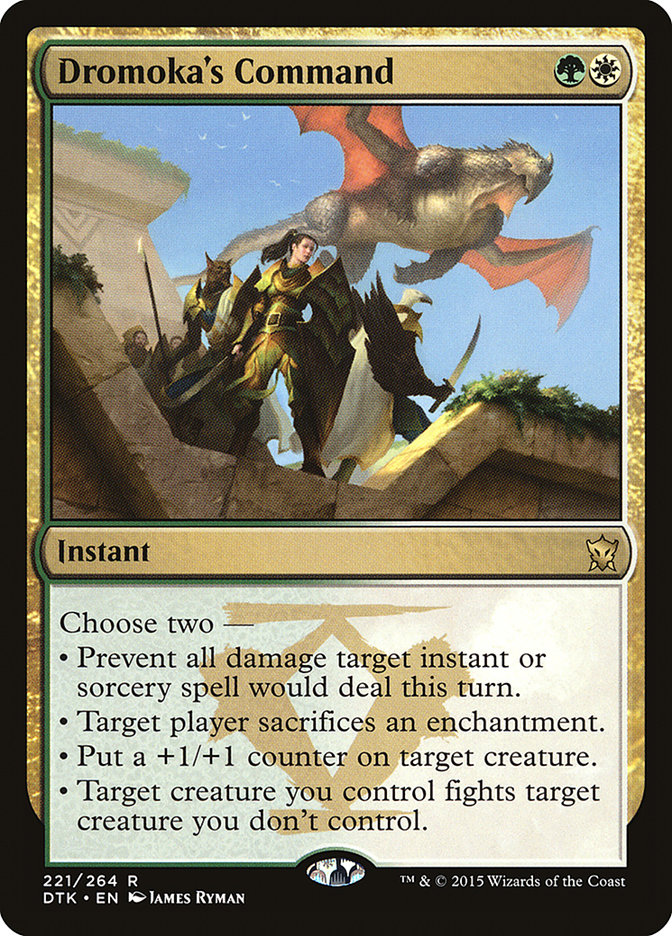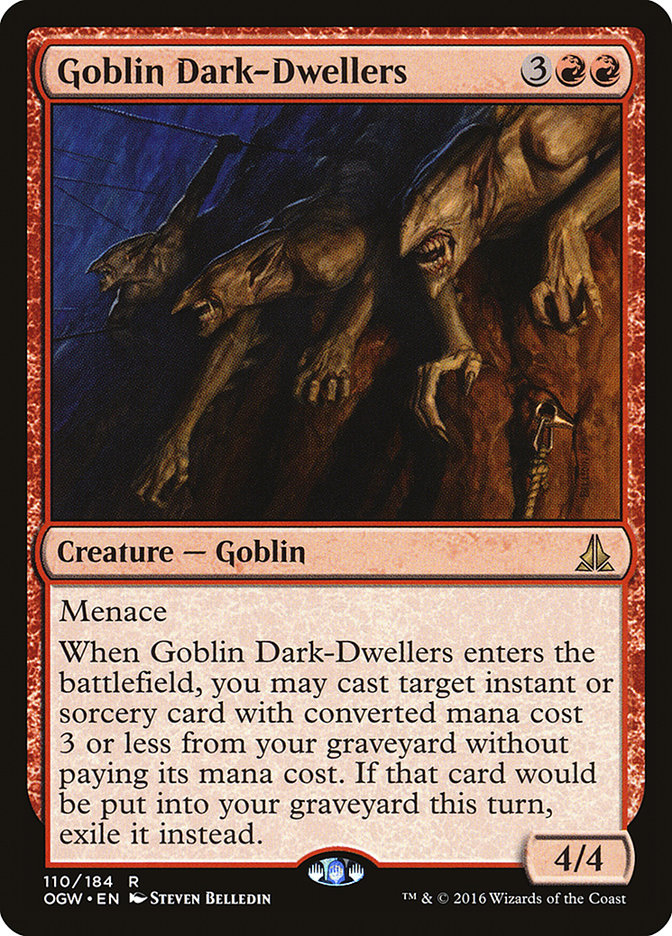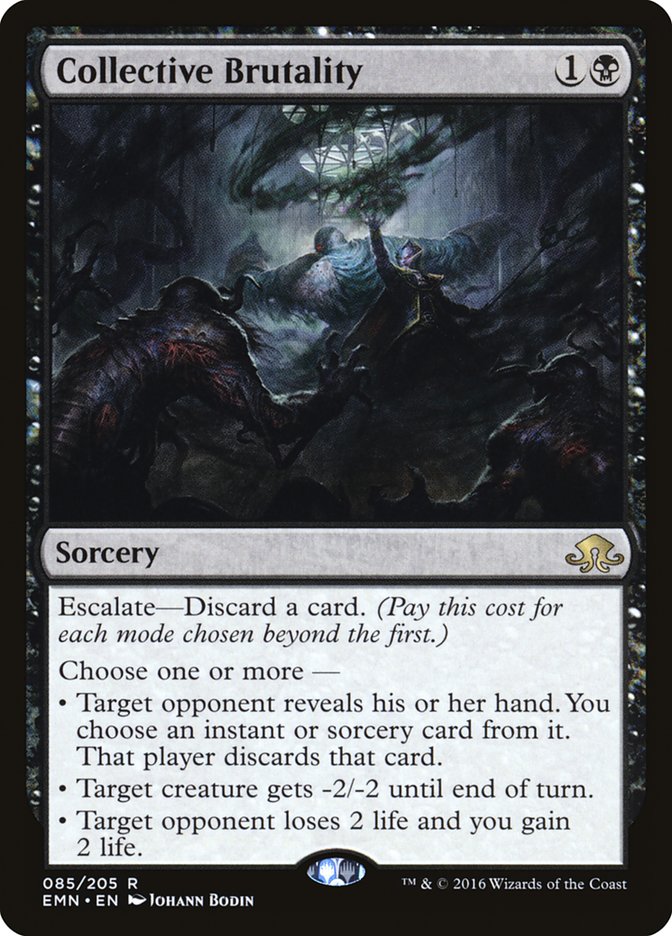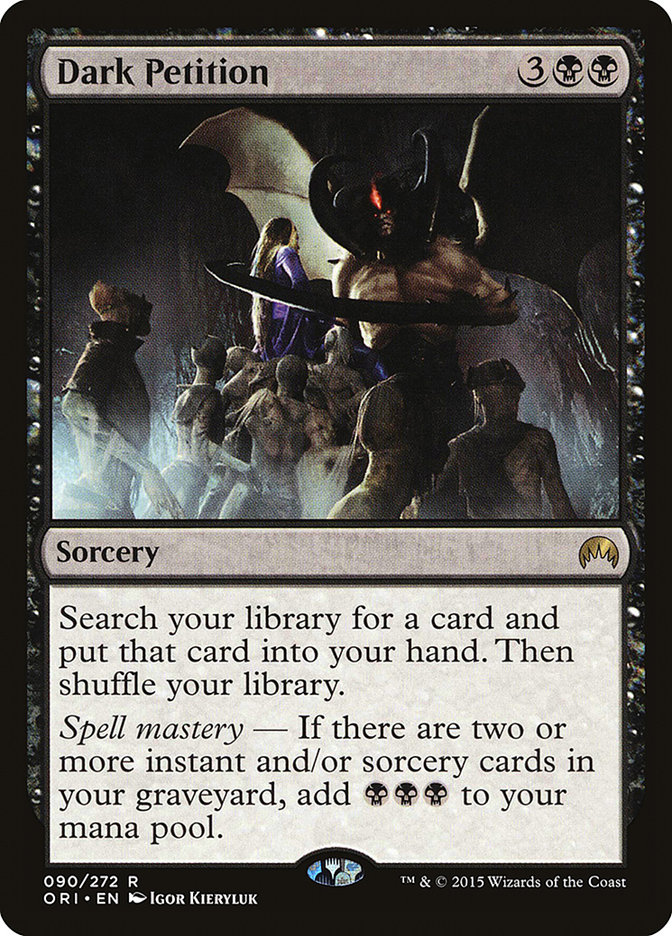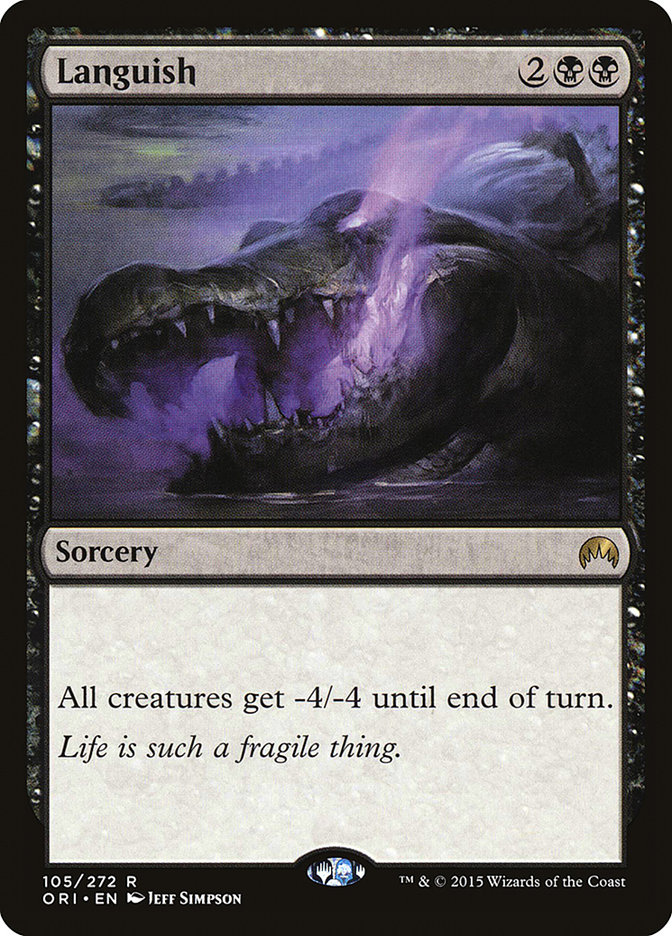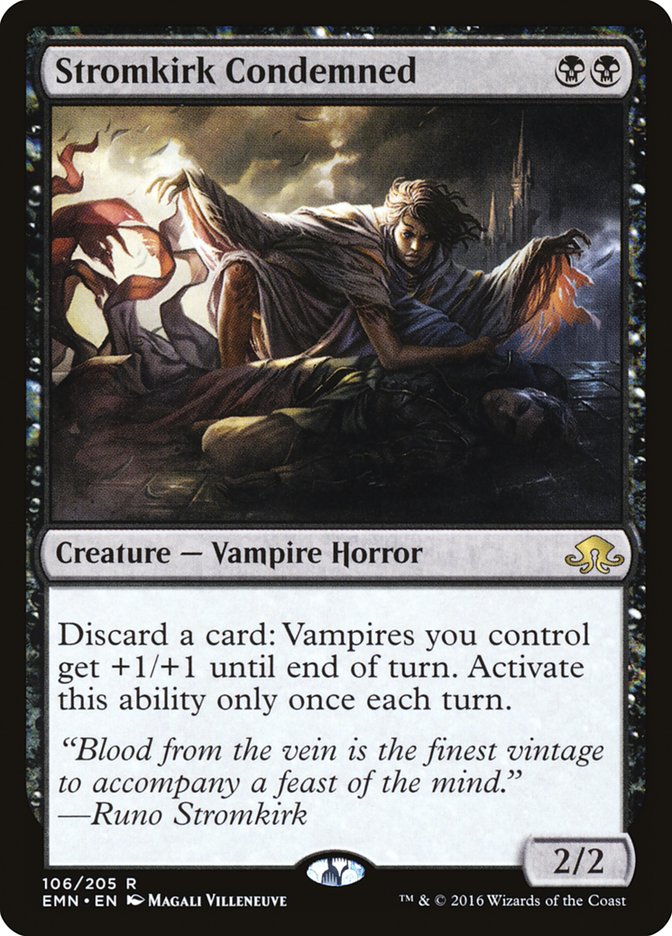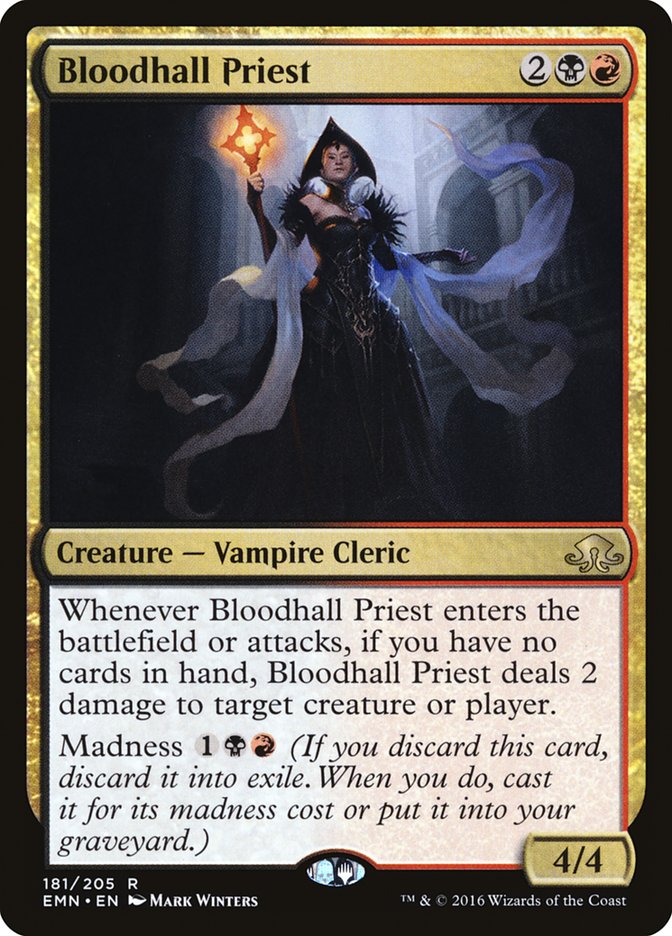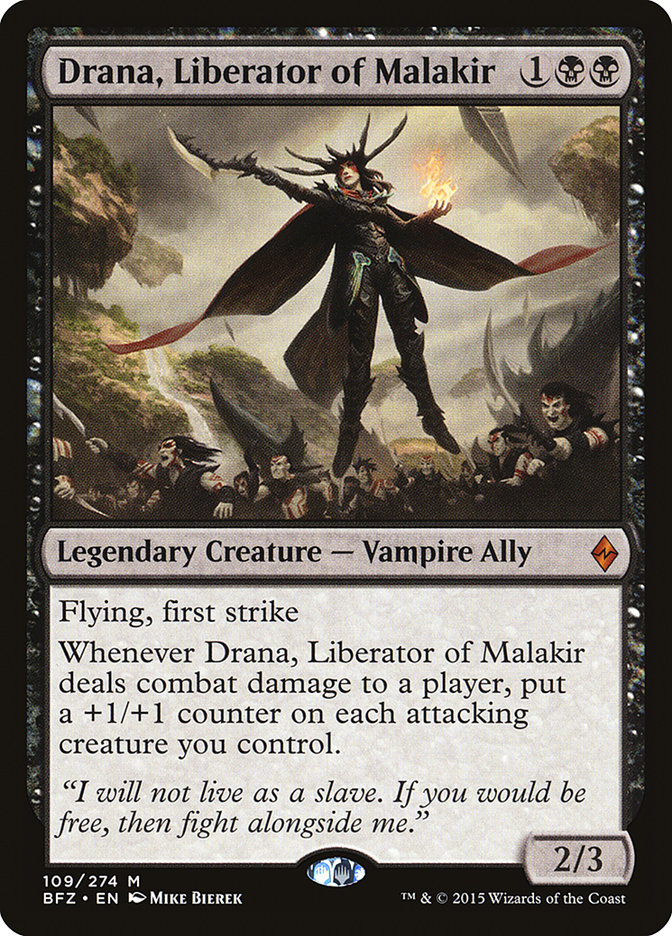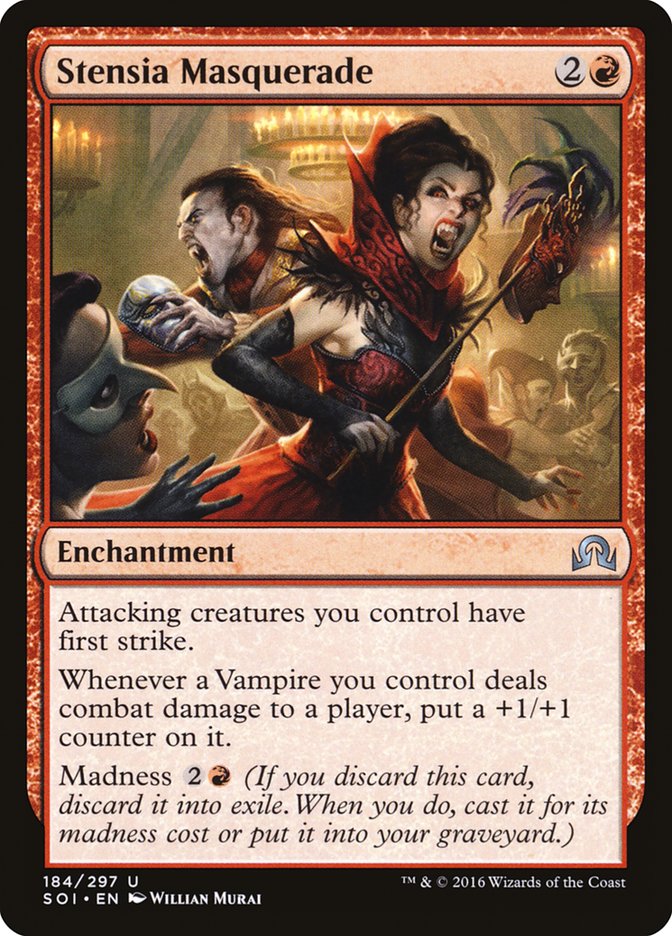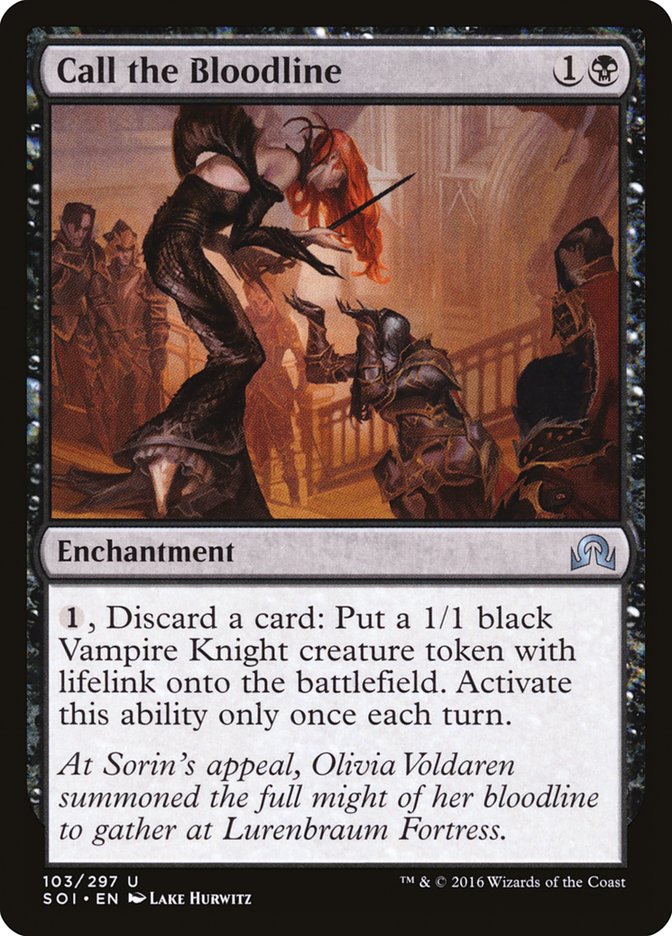Don’t get me wrong. I love G/W Tokens.
We only have eyes for you, Mike. You and half the metagame.
In fact, I love G/W tokens more than I’ve ever loved any deck in Standard. But to tell the truth, I’m a little tired of it. I know Eldritch Moon has some more really sweet white and green cards, and from the looks of it we’ll probably be cursing Dromoka’s Command until Dragons of Tarkir rotates. That said, this week we had quite a few spoilers and I wanted to take this time relatively early in spoiler season to point out a couple of the cool decks that can be built in Standard with the cards we have seen. I decided that, since we’ve all been Selesnya-flooded for the past few months, let’s take a look at some interesting Rakdos decks we can try to build in Eldritch Moon Standard.
Harmful Offerings
The first deck I’d like to talk about is a good old-fashioned combo deck. This week, Harmless Offering was spoiled, which is a functional reprint of Donate. Donate with Illusions of Grandeur used to be one of the most powerful combo decks in Magic.
What do we have in Standard that is as powerful as one of the best combos of all time? Well, nothing, sorry to disappoint you. We do have a card that has the ability to win the game when paired with Harmless Offering, though.
Why is this combo not as good as Illusions Donate? Well, we can’t cast these two spells in the same turn and win the game. We have to play the slow waiting game of letting Demonic Pact fade away down to the “lose the game” option before we can win with this combo.
That said, Demonic Pact can draw us two cards, make our opponent discard two, kill a creature while gaining us four life, and then win the game. Sounds awesome, right? Well, honestly it does sound awesome, but Dromoka’s Command is a thing. Dromoka’s Command busts up the combo on its own, and right now it’s difficult to find a good Standard deck not equipped with four Dromoka’s Command.
That said, we still have some more cards we haven’t seen and maybe things will change. If things do change, maybe this is a starting point of a sweet combo deck. In the meanwhile we can have some fun with it.
Planeswalkers (2)
Lands (25)
Spells (33)

This is very similar to a traditional B/R Control deck I built in testing for the last Pro Tour. In fact, I built this deck along with Steve Rubin, and we scrapped it before ever playing a game. Why? Well, the win conditions at the time were only Kalitas, Traitor of Ghet; Goblin Dark-Dwellers; and Chandra, Flamecaller. Six to seven creatures that weren’t particularly resilient and three copies of a six-mana planeswalker as my only ways to win the game? It just felt too soft to me. Oliver Tiu played a similar deck at Pro Tour Shadows over Innistrad to an excellent finish, adding blue for Jace, Vryn’s Prodigy and Wandering Fumarole as additional threats. Later this Grixis Control deck evolved into having Dragonlord Silumgar in the maindeck as well for an additional way to close the game.
Harmless Offering with Demonic Pact allows us to win the game without having to keep our very few creatures alive or add any additional colors. Adding this combo to a control deck allows the game to go longer, giving us the time we need for the combo to mature.
We do, however, have the option of transforming into that very same B/R Control deck with Kalitas, Traitor of Ghet and Goblin Dark-Dwellers in the sideboard. We can play the Splinter Twin combo sideboard dance with our opponent, keeping them guessing if we are leaving in our combo or sideboarding in our creatures instead. This plan seems very reasonable because our opponent will be light on ways to interact with our win conditions if we plan appropriately.
As I stated before, Dromoka’s Command is a big problem for this deck. We not only have to cast both Demonic Pact and Harmless Offering, we have to wait until Demonic Pact triggers four times, and the fourth time has to be under the opponent’s control. This gives the opponent plenty of time to draw a Dromoka’s Command or even just kill us.
There are a few ways we can protect ourselves from Dromoka’s Command. The first step I took in this decklist is adding four copies of Duress.
We can try to Duress our opponent’s Dromoka’s Commands and then hope they don’t topdeck more after we start to combo. Additionally I’ve added a “fifth” copy of Duress in Collective Brutality.
Collective Brutality acts as both a way to kill a small creature and a two-mana Duress. Collective Brutality can’t take enchantments, artifacts, or planeswalkers like Duress can, but when our major concerns are Collective Company and Dromoka’s Command, it’ll do the trick.
Another way we could build our deck in an effort to insulate ourselves from Dromoka’s Command is adding Oath of Chandra to our deck instead of some copies of Grasp of Darkness or Fiery Impulse. Now the major issue with this plan is we’d have to have our opponent tapped out when we cast our Harmless Offering. If we try to Harmless Offering while they are not tapped out, they can just choose themselves to sacrifice an enchantment with Dromoka’s Command. However, we could still Duress them before we offer them our Demonic Pact, forcing them to cast Dromoka’s Command before it resolves, and Oath of Chandra will protect us from sacrificing our Demonic Pact. Either way, this is too many if’s for me to decide to not include the Oath of Chandra initially.
One thing I do like about this deck is how well it will use Dark Petition. Dark Petition can find either combo piece or a Languish. When in need, Dark Petition can also go find some of our important sideboard cards in sideboarded games, and we can really stretch our sideboard by playing some singleton cards while Dark Petition acts as effectively extra copies of those cards.
Alternatively to Harmless Offering and Demonic Pact, there is another combo we can slot right into the exact same shell. Triskaidekaphobia combined with Tree of Perdition is also a two-card combo that can kill your opponent during their upkeep. If you went this route, I’d suggest adding a copy or two of Hanweir Battlements, allowing you to give the Tree of Perdition haste and use it in response to a removal spell.
In the end, I don’t think this deck will be good in a field full of Dromoka’s Command, but if the metagame shifts some, this might be a cool way to approach the format. I definitely think this deck will be a ton of fun for all the combo lovers out there. I know I’ll definitely give it a try.
This Deck Sucks. Blood, That is!
The next Rakdos deck I want to talk about is Vampires. Vampires had some hype coming out of Shadows over Innistrad and ultimately fell extremely short of the hype. What looked like it could be a cool new madness deck turned into an idea that I never personally saw in tournament play even once.
With that said, we got some new Vampires spoiled this week, and maybe they have what it takes to make the deck viable. Let’s at least try to look at a couple of options.
The most notable card I noticed that really pushes the Vampires archetype is Stromkirk Condemned.
Stromkirk Condemned acts as a Vampire lord, pumping all of your Vampires at the cost of discarding a card, something we don’t mind doing anyway because we can cast some for their madness costs. This ability really incentivizes us to build our deck with exclusively Vampires, and a lot of cheap ones at that, to get the most effect per activation. Unfortunately we can only activate Stromkirk Condemned once per turn.
Another Vampire card I am interested in trying is Bloodhall Priest. Bloodhall Priest is a four mana 4/4 at face value, but when madness is paid it only costs three total mana. In addition to this, we get to Shock a creature or player when it attacks or enters the battlefield when we are hellbent. With Bloodhall Priest we really want to be able to empty our hand quickly to capitalize on its ability. Playing a lot of cheap creatures will allow us to do that.
This is a B/R Vampires list I came up with on the more aggressive end of the spectrum:
Creatures (29)
- 2 Drana, Liberator of Malakir
- 4 Heir of Falkenrath
- 2 Ravenous Bloodseeker
- 4 Falkenrath Gorger
- 3 Indulgent Aristocrat
- 4 Asylum Visitor
- 4 Insolent Neonate
- 2 Bloodhall Priest
- 4 Stromkirk Condemned
Lands (23)
Spells (8)

This deck plays as a creature swarm deck with both Stensia Masquerade and Stromkirk Condemned to pump our team. The awkward part about a build like this is the mana. Six enters-the-battlefield-tapped lands aren’t ideal with a bunch of one-drops. Foreboding Ruins allows us to play a red one-drop and follow it up with Stromkirk Condemned, which is solid, but it’s okay if we play Stromkirk Condemned on a later turn as well. We just want to flood the battlefield and then start pumping the team to get the opponent dead as fast as possible.
The three-drop slot is the most difficult to fill. We have a ton of reasonable options with Olivia, Mobilized for War; Drana, Liberator of Malakir; and Stensia Masquerade. We can madness out both Bloodhall Priest and Incorrigible Youths for three mana.
Drana, Liberator of Malakir is another Anthem effect for this all-in version of the deck. I prefer having Drana, Liberator of Malakir to Olivia, Mobilized for War in a deck where three mana is at the top of the curve because the effect of Drana, Liberator of Malakir will hit all of our creatures on the battlefield, while Olivia, Mobilized for War might not enter the battlefield until our hand is empty of other creatures.
Stensia Masquerade seems like it may be really effective with a lot of high-powered creatures with low toughness, such as Asylum Visitor, Heir of Falkenrath, and a pumped Ravenous Bloodseeker. The ability to give first strike at instant speed with madness and act as an Anthem effect may make this card better than it looks. In fact, this card is the reason to play so many one-drops and keep the curve low or to even build the deck like this in the first place.
Stromkirk Occultist is an interesting new Vampire that could also fit into this deck. It churns out card advantage when it deals damage to our opponent and also is a good turn 3 madness play with Lightning Axe. Killing an opponent’s blocker in the end step and then casting Stromkirk Occultist off madness gives us a big tempo boost as well as some card advantage. It’s possible that we replace a creature higher on the curve with Stromkirk Occultist; my best guess would be to cut Bloodhall Priest or Drana, Liberator of Malakir if you wanted to try Stromkirk Occultist in this version of the deck.
Frankly, there are a lot of ways to build a Vampire deck, which I really like. We get to go through trial and error, playing with different versions until we find a version that’s competitive. Sometimes with tribal strategies, we are pretty much forced to play the cards they printed in that tribe. That is exactly how it felt with Vampires when Shadows over Innistrad was printed. We would simply put in all the Vampire cards, add some lands, and that was the deck, for better or worse. In fact, that’s exactly how the Colorless Eldrazi deck was originally built for Pro Tour Oath of the Gatewatch. This time around, it feels like we have enough options to make some real deckbuilding decision, and even build completely different versions of the same tribal deck.
Take for example a more traditional approach to building a Vampires deck, and likely it’s the better of the two versions:
Creatures (28)
- 2 Kalitas, Traitor of Ghet
- 4 Heir of Falkenrath
- 4 Ravenous Bloodseeker
- 2 Olivia, Mobilized for War
- 4 Asylum Visitor
- 4 Bloodhall Priest
- 4 Stromkirk Condemned
- 4 Stromkirk Occultist
Lands (24)
Spells (8)
Sideboard

The strength in a deck like Vampires is its ability to curve out consistently. You will rarely play games with a deck like this and not use your mana in the first three or four turns of the game. The weakness of a deck like this is it’s very hard to beat sweepers and decks heavy with removal.
This deck has very few ways to get back into a game when it’s behind; it either needs to race the opponent or come out way ahead. Once the opponent takes control of the game, the topdecks are extremely weak in a deck like this because most of the cards don’t generate any additional value on their own. Your cards will simply be outclassed.
One way to fight a bunch of removal and sweepers is with Call the Bloodline.
Call the Bloodline allows us to play madness creatures on our opponent’s turn and it does not get removed by sweepers itself. The problem with a creature discard outlet is there is no way to put our madness creatures onto the battlefield at instant speed, avoiding a sweeper. This is where Call the Bloodline will be effective. Instead of overextending, we get to see what action our opponent takes and decide if we want to add additional creatures to the battlefield.
Elusive Tormentor is another way to fight decks heavy with removal. It allows us to play a creature that is somewhat resilient to both sweepers and targeted removal spells. Be careful, because Elusive Tormentor will die to Languish on both sides.
Ultimately I think Vampires may just be a weaker deck than Humans. Flavor fail, I know. In the meantime, though, we can keep trying new ideas and developing them or moving onto the next one to see exactly what works and what doesn’t.
A Tried and True Brewing Method
Every time I get an idea for a deck, I make a note in my phone. When I have some time, I take a glance at my notes. I’ll usually log on to Magic Online and build a few versions of what I think any given deck idea might look like. If a new set is out, I “proxy” the new cards with random other cards with the same casting cost. Obviously this would work with paper cards too. Whatever your method, especially during spoiler season, I encourage you to brew and try a variety of versions of different decks to find one that both looks and feels right. If you never find it, move on to the next idea. That’s half the fun!
G/W Tokens was very good to me, and very good to a lot of other players. I do however, want to see more diversity in Standard and hope to see some more powerful black and red cards come out of Eldritch Moon. I don’t quite think these Rakdos decks are where they need to be, but I think it’s a good starting point in finding out what we can do to start Rakdos’s Return.



